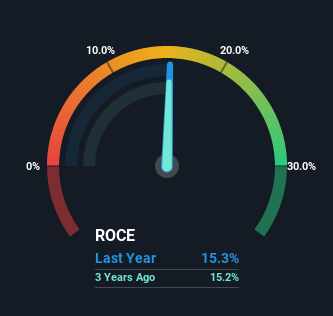- India
- /
- Household Products
- /
- NSEI:EVEREADY
Eveready Industries India (NSE:EVEREADY) Could Be Struggling To Allocate Capital

If you're looking for a multi-bagger, there's a few things to keep an eye out for. In a perfect world, we'd like to see a company investing more capital into its business and ideally the returns earned from that capital are also increasing. If you see this, it typically means it's a company with a great business model and plenty of profitable reinvestment opportunities. However, after investigating Eveready Industries India (NSE:EVEREADY), we don't think it's current trends fit the mold of a multi-bagger.
Understanding Return On Capital Employed (ROCE)
If you haven't worked with ROCE before, it measures the 'return' (pre-tax profit) a company generates from capital employed in its business. Analysts use this formula to calculate it for Eveready Industries India:
Return on Capital Employed = Earnings Before Interest and Tax (EBIT) ÷ (Total Assets - Current Liabilities)
0.15 = ₹770m ÷ (₹9.4b - ₹4.4b) (Based on the trailing twelve months to June 2022).
Therefore, Eveready Industries India has an ROCE of 15%. In absolute terms, that's a satisfactory return, but compared to the Household Products industry average of 11% it's much better.
Check out our latest analysis for Eveready Industries India

While the past is not representative of the future, it can be helpful to know how a company has performed historically, which is why we have this chart above. If you want to delve into the historical earnings, revenue and cash flow of Eveready Industries India, check out these free graphs here.
How Are Returns Trending?
In terms of Eveready Industries India's historical ROCE movements, the trend isn't fantastic. Over the last five years, returns on capital have decreased to 15% from 28% five years ago. However it looks like Eveready Industries India might be reinvesting for long term growth because while capital employed has increased, the company's sales haven't changed much in the last 12 months. It's worth keeping an eye on the company's earnings from here on to see if these investments do end up contributing to the bottom line.
On a separate but related note, it's important to know that Eveready Industries India has a current liabilities to total assets ratio of 46%, which we'd consider pretty high. This can bring about some risks because the company is basically operating with a rather large reliance on its suppliers or other sorts of short-term creditors. Ideally we'd like to see this reduce as that would mean fewer obligations bearing risks.
The Key Takeaway
Bringing it all together, while we're somewhat encouraged by Eveready Industries India's reinvestment in its own business, we're aware that returns are shrinking. Unsurprisingly, the stock has only gained 18% over the last five years, which potentially indicates that investors are accounting for this going forward. So if you're looking for a multi-bagger, the underlying trends indicate you may have better chances elsewhere.
One more thing, we've spotted 2 warning signs facing Eveready Industries India that you might find interesting.
While Eveready Industries India may not currently earn the highest returns, we've compiled a list of companies that currently earn more than 25% return on equity. Check out this free list here.
Valuation is complex, but we're here to simplify it.
Discover if Eveready Industries India might be undervalued or overvalued with our detailed analysis, featuring fair value estimates, potential risks, dividends, insider trades, and its financial condition.
Access Free AnalysisHave feedback on this article? Concerned about the content? Get in touch with us directly. Alternatively, email editorial-team (at) simplywallst.com.
This article by Simply Wall St is general in nature. We provide commentary based on historical data and analyst forecasts only using an unbiased methodology and our articles are not intended to be financial advice. It does not constitute a recommendation to buy or sell any stock, and does not take account of your objectives, or your financial situation. We aim to bring you long-term focused analysis driven by fundamental data. Note that our analysis may not factor in the latest price-sensitive company announcements or qualitative material. Simply Wall St has no position in any stocks mentioned.
About NSEI:EVEREADY
Eveready Industries India
Manufactures and markets dry cell batteries, flashlights, and lighting and electrical products in India and internationally.
Solid track record with excellent balance sheet and pays a dividend.
Similar Companies
Market Insights
Community Narratives



